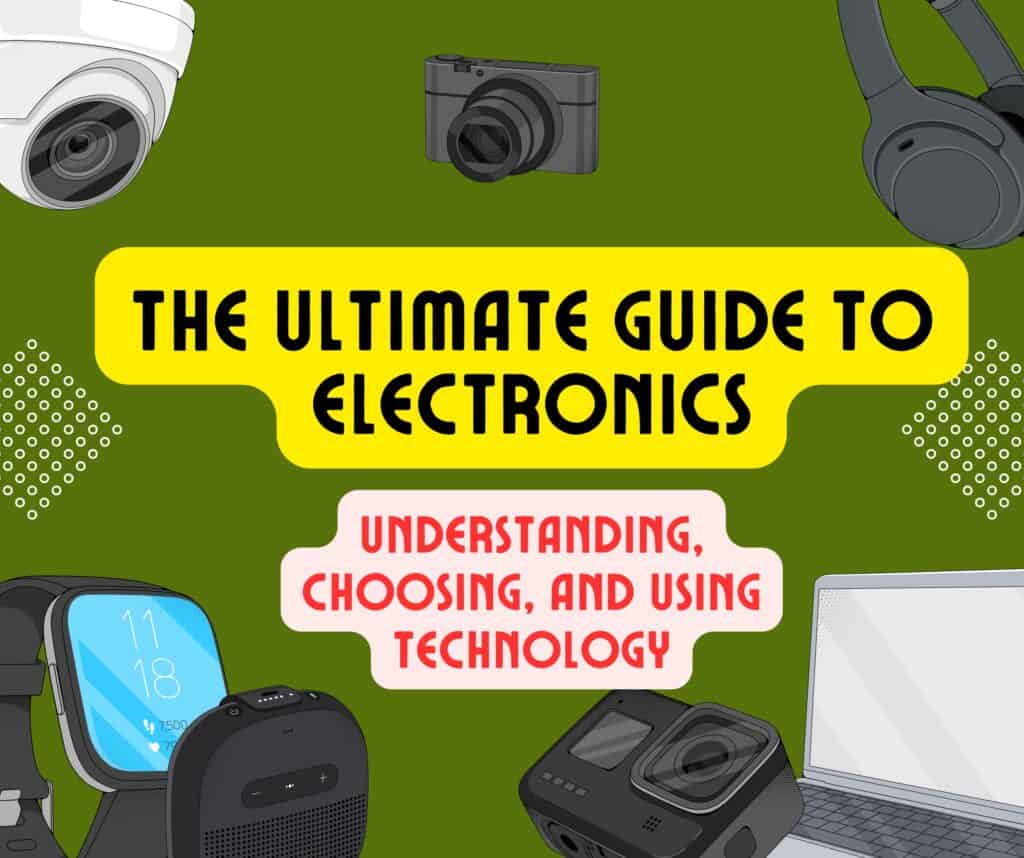Electronics is a branch of science and technology that deals with the flow of electric charge through various materials, particularly semiconductors. It encompasses the design and application of devices that utilize electrical energy for various functions, such as information processing, communication, control, and automation. From simple circuits found in household appliances to complex systems used in space exploration, electronics plays a vital role in shaping the modern technological landscape.
Importance in Modern Life
In today’s fast-paced world, electronics has become integral to nearly every aspect of daily life. Our communication methods have evolved dramatically, with smartphones and tablets allowing us to connect instantly across the globe. Home automation systems enable us to control our living environments with ease, enhancing comfort and efficiency. In the workplace, electronic devices drive productivity and innovation, streamlining processes and facilitating remote work. Furthermore, advancements in medical electronics are revolutionizing healthcare, providing tools for diagnosis, monitoring, and treatment that significantly improve patient outcomes.
The pervasive influence of electronics extends beyond individual use; it is a cornerstone of modern society. It underpins industries such as entertainment, transportation, finance, and education, contributing to economic growth and development. As technology continues to advance, understanding electronics becomes essential for navigating the future.
Brief Overview of Topics Covered in the Article
In this comprehensive guide to electronics, we will delve into several key areas to enhance your understanding and appreciation of this dynamic field. We will explore the various types of electronics, including consumer, industrial, medical, and telecommunications devices, highlighting their unique characteristics and applications.
Next, we’ll discuss the fundamental components that make up electronic devices, such as resistors, capacitors, transistors, diodes, and integrated circuits, explaining their functions and significance in circuit design.
We will also cover the principles of how electronics work, providing insights into basic electrical concepts and circuit configurations.
For those looking to purchase electronic devices, we will offer valuable tips and considerations to help you make informed decisions, ensuring you select products that meet your needs and budget.
Additionally, we will address the importance of maintaining and troubleshooting electronics, offering practical advice for keeping your devices in optimal condition.
Lastly, we’ll examine future trends in electronics, including emerging technologies, sustainable practices, and the growing prevalence of wearable technology, giving you a glimpse into the innovations that will shape our lives in the years to come.
By the end of this article, you will have a thorough understanding of electronics, empowering you to engage with technology more effectively in both personal and professional contexts.
Stop wishing for success—start working for it. Click here to begin!
Try Wealthy Affiliate (For Free).
Types of Electronics
Electronics can be broadly classified into several categories based on their applications and functions. Understanding these different types helps consumers and professionals alike make informed decisions about the devices they use or develop. Below, we delve into four main categories of electronics: consumer, industrial, medical, and telecommunication electronics.
A. Consumer Electronics
Consumer electronics are devices designed for personal use, primarily intended for entertainment, communication, and information purposes. They are widely available in the market and have become an essential part of daily life.
- Smartphones
- Description: Smartphones are multifunctional devices that combine the functionality of a mobile phone with advanced computing capabilities. They enable users to make calls, send texts, access the internet, and run a wide array of applications.
- Features: Most smartphones include high-resolution cameras, GPS navigation, and multimedia capabilities, allowing for photography, video recording, and streaming services. Popular operating systems include iOS and Android, each offering a unique user experience and ecosystem of apps.
- Laptops and Tablets
- Description: Laptops are portable computers that offer the same functionality as desktop PCs, while tablets are touch-screen devices that bridge the gap between smartphones and laptops.
- Features: Laptops typically feature a full keyboard, large displays, and powerful processors, making them suitable for tasks ranging from office work to gaming. Tablets, on the other hand, are lightweight and more portable, often used for browsing, reading, and consuming media. Many tablets support stylus input, making them ideal for artists and note-takers.
- Televisions
- Description: Televisions have evolved from bulky, cathode-ray tube models to sleek, high-definition screens that deliver immersive visual experiences.
- Features: Modern televisions often incorporate smart technology, allowing users to access streaming services, browse the internet, and connect with other smart devices in the home. They come in various sizes and resolutions, including 4K and 8K, providing stunning picture quality.
B. Industrial Electronics
Industrial electronics encompass devices and systems used in manufacturing, production, and automation processes. These technologies enhance efficiency, accuracy, and safety in various industries.
- Automation Systems
- Description: Automation systems involve the use of control systems to manage machinery and processes in factories and other industrial settings.
- Features: These systems can include programmable logic controllers (PLCs), sensors, and actuators that work together to streamline production, reduce human intervention, and minimize errors.
- Robotics
- Description: Robotics involves the design and application of robots that can perform tasks autonomously or semi-autonomously.
- Features: Robots are used in various sectors, including manufacturing, healthcare, and logistics, to perform repetitive tasks, assemble products, or assist in surgeries. Advances in AI and machine learning are enhancing the capabilities and flexibility of robotic systems.
- Process Control Systems
- Description: Process control systems monitor and control industrial processes, ensuring they operate within specified parameters.
- Features: These systems often utilize sensors and feedback loops to regulate temperature, pressure, flow, and other critical variables, optimizing performance and maintaining product quality.
C. Medical Electronics
Medical electronics are specialized devices and systems designed for healthcare applications. They play a crucial role in diagnostics, monitoring, and treatment.
- Diagnostic Equipment
- Description: Diagnostic equipment includes devices used to identify diseases and medical conditions.
- Examples: Common examples include electrocardiograms (ECGs) for heart monitoring, blood glucose meters for diabetes management, and ultrasound machines for imaging.
- Monitoring Devices
- Description: Monitoring devices are used to track patients’ vital signs and other health parameters in real time.
- Features: These can include wearable devices like fitness trackers, heart rate monitors, and more complex systems used in hospitals to continuously monitor patients’ conditions.
- Imaging Systems
- Description: Imaging systems utilize advanced technologies to create visual representations of the interior of a body for clinical analysis and medical intervention.
- Examples: Examples include MRI (Magnetic Resonance Imaging), CT (Computed Tomography) scans, and X-ray machines, all of which assist healthcare professionals in diagnosing and planning treatment.
D. Telecommunication Electronics
Telecommunication electronics involve devices and systems that facilitate communication over distances, enabling the exchange of information through various channels.
- Communication Devices
- Description: Communication devices include telephones, radios, and video conferencing systems that allow individuals to connect and communicate.
- Features: These devices have evolved significantly with advancements in technology, integrating features like VoIP (Voice over Internet Protocol), video calls, and messaging applications.
- Networking Equipment
- Description: Networking equipment includes devices that enable data exchange between computers and other devices over a network.
- Examples: Routers, switches, modems, and access points are essential components of modern networks, facilitating internet connectivity and communication within homes and businesses.
Affiliate Notice: This post includes affiliate links, which means I may earn a commission if you make a purchase. These links provide access to valuable resources like free training and tools for your online success.
Try Wealthy Affiliate (For Free).
Key Components of Electronic Devices
Understanding the key components of electronic devices is essential for anyone looking to grasp how electronics function. Each component plays a crucial role in manipulating electrical signals and ensuring devices operate as intended. Below, we explore five fundamental components: resistors, capacitors, transistors, diodes, and integrated circuits (ICs).
A. Resistors
Function and Types
Resistors are passive components that limit the flow of electrical current in a circuit. They are essential for controlling voltage and current levels, ensuring that other components receive the appropriate amounts of electricity.
- Function: The primary purpose of a resistor is to provide resistance, measured in ohms (Ω). By doing so, resistors help prevent damage to sensitive components and enable proper functioning of electronic circuits.
- Types:
- Fixed Resistors: These have a constant resistance value and are commonly used in various applications.
- Variable Resistors (Potentiometers): These allow users to adjust resistance manually, making them useful for applications like volume control in audio devices.
- Thermistors: These resistors change resistance based on temperature, often used in temperature sensing and compensation.
- Photoresistors: Their resistance varies with light intensity, making them suitable for light-sensing applications.
B. Capacitors
Purpose and Varieties
Capacitors are passive components that store and release electrical energy in a circuit. They play a vital role in energy storage, filtering, and signal processing.
- Purpose: Capacitors accumulate electric charge and release it when needed, helping to smooth out voltage fluctuations and stabilize power supplies. They are commonly used in timing circuits, audio equipment, and power supply applications.
- Varieties:
- Electrolytic Capacitors: Known for their large capacitance values, these are often used in power supply circuits.
- Ceramic Capacitors: These are small and stable, making them suitable for high-frequency applications.
- Tantalum Capacitors: They offer high capacitance in a compact size and are used in space-constrained applications.
- Film Capacitors: These are durable and reliable, commonly used in audio and high-voltage applications.
C. Transistors
Role in Amplification and Switching
Transistors are semiconductor devices that act as switches or amplifiers in electronic circuits. They are fundamental building blocks of modern electronics.
- Role: In amplification, transistors increase the strength of an electrical signal, allowing weak signals to be processed and transmitted effectively. As switches, they control the flow of current in a circuit, enabling the on/off functionality of various devices.
- Types:
- Bipolar Junction Transistors (BJTs): These are current-controlled devices that come in two types: NPN and PNP, each with specific applications.
- Field-Effect Transistors (FETs): These are voltage-controlled devices, including MOSFETs (Metal-Oxide-Semiconductor FETs), widely used in digital circuits and power management.
D. Diodes
Types and Applications
Diodes are semiconductor devices that allow current to flow in one direction only. They are essential for controlling the direction of electrical current in circuits.
- Types:
- Standard Diodes: Used for rectification, converting alternating current (AC) to direct current (DC).
- Zener Diodes: Designed to allow current to flow in reverse when a specific voltage is reached, commonly used for voltage regulation.
- Light Emitting Diodes (LEDs): Emit light when current flows through them, widely used in displays and lighting applications.
- Photodiodes: Convert light into electrical current, used in solar panels and light-sensing devices.
- Applications: Diodes are used in various applications, including power supplies, signal modulation, and protection circuits to prevent damage from reverse polarity.
E. Integrated Circuits (ICs)
Importance in Modern Electronics
Integrated circuits (ICs) are compact electronic circuits that combine multiple components, such as resistors, capacitors, and transistors, onto a single chip. They revolutionized electronics by significantly reducing size and cost while enhancing performance.
- Importance: ICs enable the creation of complex electronic systems in a small form factor, making them essential for modern devices like computers, smartphones, and consumer electronics. They facilitate high-speed processing, efficient power management, and reliable operation.
- Types of ICs:
- Analog ICs: Deal with continuous signals, used in amplifiers, voltage regulators, and oscillators.
- Digital ICs: Process discrete signals, used in microcontrollers, memory chips, and logic gates.
- Mixed-Signal ICs: Combine analog and digital functions, commonly used in communication devices and data converters.
How Electronics Work
Understanding how electronics function requires a grasp of fundamental electrical principles, circuit design, and the different configurations that circuits can take. This knowledge serves as a foundation for delving into more complex electronic systems. Below, we explore the basic principles of electricity, the concept of circuits, and the various types of circuit configurations.
A. Basic Principles of Electricity
Electricity is the flow of electric charge, typically carried by electrons in a conductor. It is governed by several key principles that underlie the operation of electronic devices.
- Voltage (V): Voltage is the electrical potential difference between two points in a circuit. It is the force that pushes electric charges through a conductor, measured in volts (V).
- Current (I): Current is the flow of electric charge in a circuit, measured in amperes (A). It represents the rate at which charge flows and is driven by the voltage across the circuit.
- Resistance (R): Resistance is the opposition to the flow of current, measured in ohms (Ω). Different materials offer varying levels of resistance, affecting how easily current can flow through a circuit.
- Ohm’s Law: This fundamental law defines the relationship between voltage, current, and resistance, expressed by the formula:
V=I×RV = I \times RV=I×R
According to Ohm’s Law, an increase in voltage will result in an increase in current, provided resistance remains constant.
B. Understanding Circuits
A circuit is a closed loop that allows electricity to flow from a power source, through various components, and back to the source. Circuits can be simple or complex, depending on the number of components and their interactions.
- Components of a Circuit: Essential components of an electronic circuit include:
- Power Source: Provides the necessary voltage to drive the current (e.g., batteries, power supplies).
- Conductors: Wires or traces that connect components and allow current to flow.
- Load: Any device that consumes electrical energy (e.g., resistors, LEDs, motors).
- Circuit Behavior: Circuits can be designed to perform specific functions, such as amplifying signals, turning devices on and off, or filtering noise. The interaction between components determines how the circuit behaves under various conditions.
C. Types of Circuit Configurations
The arrangement of components within a circuit affects how electricity flows and the overall performance of the circuit. The two most common configurations are series and parallel circuits.
- Series Circuits
- Description: In a series circuit, components are connected end-to-end in a single path for current flow. This means that the same current flows through each component.
- Characteristics:
- Current: The current is the same throughout the entire circuit.
- Voltage: The total voltage across the circuit is the sum of the voltages across each component.
- Resistance: The total resistance is the sum of the individual resistances: Rtotal=R1+R2+R3+…R_{\text{total}} = R_1 + R_2 + R_3 + \ldotsRtotal=R1+R2+R3+…
- Example: If one component fails (e.g., a burned-out light bulb), the entire circuit will stop working because the path for current flow is broken.
- Parallel Circuits
- Description: In a parallel circuit, components are connected across the same two points, creating multiple paths for current to flow.
- Characteristics:
- Current: The total current is the sum of the currents through each parallel branch. Each branch can carry a different current.
- Voltage: The voltage across each component is the same and equals the total voltage supplied by the power source.
- Resistance: The total resistance is found using the formula: 1Rtotal=1R1+1R2+1R3+…\frac{1}{R_{\text{total}}} = \frac{1}{R_1} + \frac{1}{R_2} + \frac{1}{R_3} + \ldotsRtotal1=R11+R21+R31+…
- Example: If one component fails, other branches can still function, allowing the circuit to continue operating.
Buying Electronics: Tips and Considerations
Purchasing electronics can be a daunting task, given the wide range of products available on the market. To make informed decisions, it’s essential to consider various factors that can impact your satisfaction with the device and its performance. Below are some key tips and considerations for buying electronics.
A. Identifying Needs
Before diving into the buying process, take time to clarify your specific needs. Understanding what you want from an electronic device will guide your decision-making.
- Determining the Purpose of the Device
- Assess Your Requirements: Are you looking for a device for personal use, work, or entertainment? For example, if you need a laptop for gaming, you’ll require higher specifications compared to one meant for basic web browsing.
- Consider Future Needs: Think about how your needs may change in the future. For instance, if you plan to expand your use of software applications or engage in more demanding tasks, opt for a device with better capabilities.
- Usability and Comfort
- User Experience: Ensure the device’s interface is user-friendly and matches your technical proficiency. Consider how comfortable you are with different operating systems (e.g., Windows, macOS, Android).
- Portability: If you need a device for on-the-go use, factors like weight and battery life will be crucial. Laptops and tablets should be lightweight and have extended battery life.
Your path to financial independence begins with a choice. Make it today!
Try Wealthy Affiliate (For Free).
B. Researching Brands and Models
Once you’ve identified your needs, it’s time to conduct thorough research on the available brands and models that fit those requirements.
- Comparing Features and Specifications
- Key Specifications: Focus on important specifications such as processor speed, RAM, storage capacity, screen resolution, and connectivity options. For example, for gaming laptops, a powerful GPU and high refresh rate are crucial.
- Brand Reputation: Look into brand reliability and customer satisfaction ratings. Research reviews and user experiences to gauge the performance and longevity of specific models.
- Unique Features: Pay attention to additional features like touchscreen capabilities, 2-in-1 versatility, or high-quality audio systems that might enhance your experience.
- Consumer Reviews
- Reading Reviews: Explore reviews on reputable websites, forums, and social media to understand how real users feel about the product’s performance and reliability.
- Professional Reviews: Check out expert reviews that often provide in-depth analyses and comparisons among different models, which can help in making a well-informed choice.
C. Budgeting
Setting a realistic budget is essential when buying electronics, as prices can vary widely depending on specifications and features.
- Setting a Realistic Budget
- Assessing Cost vs. Value: Determine how much you are willing to spend based on the features you require. It may be tempting to go for the cheapest option, but consider the value for money and long-term usability.
- Hidden Costs: Remember to account for potential hidden costs, such as accessories (like cases or software), extended warranties, and service plans.
- Cost-Effective Options
- Refurbished or Open-Box Products: Consider buying refurbished or open-box items to save money while still obtaining quality products. Ensure they come with warranties or return policies for peace of mind.
- Timing Your Purchase: Be strategic about timing your purchase. Major sales events, like Black Friday or back-to-school sales, can offer substantial discounts.
D. Warranty and Support
A manufacturer’s warranty can significantly impact your experience with a new electronic device.
- Importance of Manufacturer Warranty
- Protection Against Defects: A warranty provides assurance that you are protected against manufacturing defects or early failures. Ensure you understand the warranty terms, including duration and coverage.
- Customer Support: Check the availability of customer support services. Responsive support can be invaluable if you encounter issues or need assistance with your device.
- Extended Warranty Options
- Considering Extended Warranties: Evaluate if an extended warranty or protection plan is worth the investment based on the device’s price and your usage patterns. For high-value items, these plans may provide extra peace of mind.
E. Energy Efficiency
With increasing awareness about environmental sustainability, energy efficiency has become a critical consideration when buying electronics.
- Importance of Choosing Energy-Efficient Devices
- Lower Energy Bills: Energy-efficient devices consume less power, leading to lower electricity bills over time. Look for devices with energy-saving features or those rated by recognized energy efficiency standards, such as ENERGY STAR.
- Environmental Impact: By choosing energy-efficient electronics, you contribute to reducing your carbon footprint. This choice supports environmentally friendly practices, helping to minimize energy consumption and waste.
- Sustainability Features
- Recyclability: Check if the device is designed with recyclable materials. Many manufacturers are adopting sustainable practices, and selecting products from these companies can further align your purchasing choices with eco-friendly values.
- Durability and Longevity: Opt for products built to last, reducing the need for replacements and minimizing electronic waste.
Maintaining and Troubleshooting Electronics
Proper maintenance and troubleshooting are essential for prolonging the life of your electronic devices and ensuring they function optimally. By being proactive about care and knowing how to address common problems, you can save time and money while enhancing your overall user experience. Below are key aspects to consider regarding maintenance and troubleshooting electronics.
A. Regular Maintenance Tips
To keep your electronics in top condition, regular maintenance is crucial. This not only prevents problems but can also improve performance.
- Cleaning and Care
- Dusting and Cleaning: Regularly dust your devices to prevent buildup, which can cause overheating or hinder performance. Use a soft, dry cloth for screens and a can of compressed air to clean keyboards and vents.
- Proper Storage: Store electronics in a cool, dry place, away from direct sunlight. Avoid placing them in damp or humid areas, as moisture can cause significant damage.
- Cable Management: Organize cables to prevent tangling and wear. Use cable ties or clips to keep cords neat and out of the way. This practice also helps reduce the risk of accidents and equipment damage.
- Software Updates: Regularly check for and install software updates. Updates can improve functionality, enhance security, and fix bugs that may affect performance.
- Battery Care
- Charging Practices: For devices with rechargeable batteries, avoid letting the battery drain completely. Instead, charge it when it reaches around 20-30%. This can help prolong battery life.
- Storage of Unused Devices: If you have devices that will not be used for an extended period, store them with a charged battery, ideally around 50%. This can help maintain battery health during storage.
B. Common Issues and Solutions
Even with regular maintenance, electronics can experience issues. Knowing common problems and their solutions can help you troubleshoot effectively.
- Power Issues
- Device Won’t Turn On: If your device doesn’t power up, check the power source. Ensure that it is plugged in properly, or if it’s battery-operated, confirm the battery is charged. Try using a different outlet or charger.
- Intermittent Power Loss: This could indicate a faulty power supply or battery. If the problem persists, consider replacing the power adapter or battery as needed.
- Connectivity Problems
- Wi-Fi Connection Issues: If you’re having trouble connecting to Wi-Fi, check if other devices can connect to the network. Restart your router and device. If the issue persists, consider forgetting the network and reconnecting by entering the password again.
- Bluetooth Connectivity: If devices aren’t pairing, ensure both devices are in pairing mode. Restarting both devices can also resolve minor glitches. If issues continue, check for firmware updates.
- Performance Issues
- Slow Performance: If your device is lagging, try closing unused applications or tabs. Regularly clearing cache and temporary files can also improve performance.
- Overheating: If your device feels hot, ensure it’s on a hard surface that allows airflow. Check for dust buildup in vents and clean as necessary. If overheating continues, consider seeking professional assistance.
C. When to Seek Professional Help
While many issues can be resolved through simple troubleshooting, some problems may require professional assistance. Knowing when to seek help can save you time and prevent further damage.
- Identifying Complex Issues
- Persistent Problems: If you’ve tried standard troubleshooting steps and the issue remains unresolved, it may indicate a more serious underlying problem that requires expert diagnosis.
- Unusual Noises or Smells: Any strange noises (like clicking or grinding) or burning smells coming from your device are red flags. These could signal hardware failure or electrical issues, necessitating immediate professional evaluation.
- Physical Damage: If your device has been dropped, exposed to liquid, or shows visible damage (like cracked screens), it’s best to consult a professional technician to assess the extent of the damage and the required repairs.
- Warranty Considerations
- Utilizing Warranty Services: If your device is still under warranty, take advantage of manufacturer support. Contact customer service for guidance and to understand the claims process for repairs or replacements.
- Authorized Service Centers: Seek repairs through authorized service centers to avoid voiding warranties. These professionals are trained to handle specific brands and devices, ensuring quality repairs.
Future Trends in Electronics
The electronics industry is constantly evolving, driven by advancements in technology and changing consumer needs. Understanding future trends can help individuals and businesses stay ahead in this fast-paced environment. Below are some significant trends shaping the future of electronics.
A. Emerging Technologies
- Internet of Things (IoT)
- Definition and Impact: The Internet of Things refers to the network of interconnected devices that communicate and share data with one another. IoT technology is revolutionizing various sectors, from smart homes to industrial automation. Everyday objects, such as appliances and vehicles, are being embedded with sensors and connectivity features, allowing for enhanced functionality and efficiency.
- Smart Home Devices: Devices such as smart thermostats, security cameras, and lighting systems enable homeowners to control their environments remotely via smartphones or voice commands. This trend is promoting energy efficiency, security, and convenience in daily living.
- Industrial IoT: In industries, IoT facilitates better resource management, predictive maintenance, and streamlined operations. Smart factories equipped with IoT devices can monitor equipment performance and optimize production processes in real time, leading to increased productivity and reduced downtime.
- Artificial Intelligence (AI) Integration
- AI in Electronics: The integration of AI into electronic devices is enhancing functionality and user experience. AI algorithms can analyze data, learn from user behavior, and make predictions, enabling devices to respond intelligently to user needs.
- Smart Assistants: Devices equipped with AI-powered voice assistants, such as Amazon Alexa or Google Assistant, are becoming commonplace. These assistants can perform tasks, answer questions, and control other smart devices, making daily routines more efficient.
- AI in Manufacturing: AI is also transforming manufacturing processes. Through machine learning and automation, factories can improve quality control, reduce waste, and adapt to changing market demands, resulting in more agile and cost-effective production.
B. Sustainable Electronics
- Eco-Friendly Materials and Designs
- Sustainable Production Practices: As environmental awareness grows, the demand for sustainable electronics is increasing. Manufacturers are exploring eco-friendly materials, such as biodegradable plastics and recycled metals, to reduce their environmental impact.
- Energy-Efficient Devices: Future electronic devices are expected to prioritize energy efficiency. This includes improving battery technologies and using low-power components to minimize energy consumption during operation. Energy-efficient devices not only lower electricity costs for consumers but also reduce the overall carbon footprint of electronics.
- Circular Economy in Electronics
- Recycling and Reuse: The concept of a circular economy involves designing products for durability, reparability, and recyclability. Manufacturers are beginning to take back old devices for recycling or refurbishment, reducing electronic waste and promoting sustainable consumption.
- Eco-Labels and Certifications: As consumer interest in sustainability grows, products featuring eco-labels or certifications will likely gain popularity. These labels provide assurance that products meet specific environmental standards, helping consumers make informed choices.
C. Wearable Technology
- Growth in Health Monitoring Devices
- Health and Fitness Trackers: Wearable devices, such as smartwatches and fitness trackers, are increasingly popular for health monitoring. These devices can track physical activity, heart rate, sleep patterns, and more, providing users with valuable insights into their health and wellness.
- Medical Wearables: Beyond fitness, wearable technology is making strides in healthcare. Devices that monitor chronic conditions, deliver medication reminders, or even detect health anomalies in real time are being developed. This trend is paving the way for more personalized and proactive healthcare solutions.
- Integration with Other Technologies
- Connectivity and Data Sharing: Wearables are often designed to sync with smartphones and other devices, enabling users to track their health metrics and share data with healthcare providers seamlessly. This connectivity facilitates remote monitoring and enhances patient engagement in managing their health.
- Augmented Reality (AR) in Wearables: The future of wearables may also include augmented reality technology, allowing users to overlay digital information onto their physical environment. This application can enhance training, education, and even entertainment experiences.
Conclusion
As we wrap up our exploration of electronics, it is essential to recognize the profound impact these technologies have on our daily lives. From the smartphones we carry in our pockets to the smart appliances in our homes, electronics play a pivotal role in enhancing our convenience, efficiency, and connectivity.
Turn your passion into profit. Click here to start your business now!
Try Wealthy Affiliate (For Free).
A. Recap of the Importance of Electronics in Daily Life
Electronics have transformed the way we communicate, work, learn, and entertain ourselves. They are integral to various aspects of our lives, enabling us to:
- Stay Connected: With the rise of smartphones and communication devices, staying in touch with family, friends, and colleagues is easier than ever. Social media platforms, video calls, and instant messaging allow us to connect globally, fostering relationships across distances.
- Enhance Productivity: Electronic devices such as laptops, tablets, and software applications have revolutionized the workplace, enabling remote work and collaboration. Whether it’s managing projects, conducting research, or attending virtual meetings, electronics streamline workflows and enhance productivity.
- Improve Health and Well-Being: The growing popularity of wearable technology and health-monitoring devices empowers individuals to take control of their health. From fitness tracking to telemedicine, electronics facilitate proactive health management, making it easier to monitor and improve our well-being.
- Advance Learning Opportunities: Education has been transformed by electronic devices and online resources. Students can access a wealth of information, engage in interactive learning experiences, and connect with educators and peers, all thanks to technology.
B. Encouragement to Stay Informed About Technological Advancements
The field of electronics is continuously evolving, with new technologies and innovations emerging at a rapid pace. To fully harness the benefits of these advancements, it’s crucial to stay informed. Keeping up with the latest trends allows you to:
- Make Informed Decisions: Understanding the features and capabilities of the latest devices enables you to choose products that best suit your needs. Knowledge about technological advancements can also guide you in upgrading or replacing old devices with more efficient options.
- Adapt to Changes: As technology progresses, it influences various sectors, including healthcare, education, and entertainment. Staying informed helps you adapt to these changes and leverage new opportunities, whether in your professional life or personal interests.
- Engage with the Community: Being aware of emerging technologies fosters engagement with communities, whether online or in-person. Discussions, workshops, and seminars can enhance your understanding and create networking opportunities with like-minded individuals.
C. Call to Action: Explore Various Electronic Devices and Their Applications
Now that you have gained insight into the importance of electronics and the exciting trends shaping the industry, it’s time to take action. Here are some steps you can take:
- Explore: Dive into the world of electronics by researching various devices. Whether you’re interested in the latest smartphones, smart home technology, or wearable devices, exploring different options will help you find products that enhance your daily life.
- Experiment: If possible, try out new devices and technologies. Visit electronics stores or attend tech fairs to get hands-on experience. Many retailers offer demonstration units, allowing you to test features and functionalities before making a purchase.
- Stay Engaged: Follow tech blogs, subscribe to industry newsletters, and join online forums or communities dedicated to electronics. This engagement will keep you informed about product releases, reviews, and emerging trends.
In conclusion, electronics are an integral part of our lives, continuously shaping how we interact with the world around us. By staying informed and actively exploring new technologies, you can unlock the full potential of electronics and enhance your everyday experiences.
We’d love to hear from you! What are your favorite electronic devices, and how have they transformed your daily life? Do you have any questions about the latest technologies or trends in electronics? Your insights and experiences are valuable, and sharing them can help foster a vibrant community of tech enthusiasts.
Feel free to leave your thoughts or questions in the comments section below. Let’s start a conversation about the exciting world of electronics and how it continues to shape our lives!







